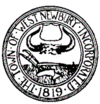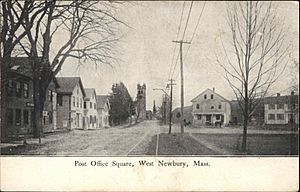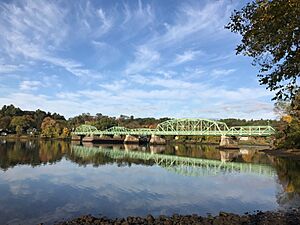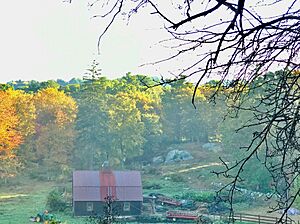West Newbury, Massachusetts facts for kids
Quick facts for kids
West Newbury, Massachusetts
|
||
|---|---|---|
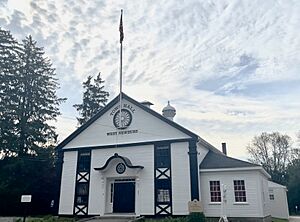
West Newbury Town Hall, 2023
|
||
|
||
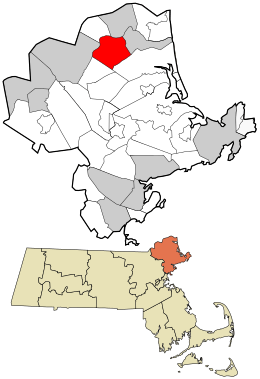
Location in Essex County and the state of Massachusetts.
|
||
| Country | United States | |
| State | Massachusetts | |
| County | Essex | |
| Settled | 1635 | |
| Incorporated | 1819 | |
| Government | ||
| • Type | Open town meeting | |
| Area | ||
| • Total | 14.7 sq mi (38.1 km2) | |
| • Land | 13.4 sq mi (34.8 km2) | |
| • Water | 1.3 sq mi (3.3 km2) | |
| Elevation | 92 ft (28 m) | |
| Population | ||
| • Total | 4,500 | |
| • Density | 306/sq mi (118.1/km2) | |
| Time zone | UTC−5 (EST) | |
| • Summer (DST) | UTC−4 (Eastern) | |
| ZIP Code |
01985
|
|
| Area code(s) | 351/978 | |
| FIPS code | 25-77150 | |
| GNIS feature ID | 0618313 | |
West Newbury is a small town in Essex County, Massachusetts, United States. It sits right on the Merrimack River. In 2020, about 4,500 people lived there.
Contents
Discovering West Newbury's Past
West Newbury was first home to the Agawam and Naumkeag Native American groups. English settlers arrived in 1635. They made it part of the nearby town of Newbury. About 15 years later, settlers bought 30 acres of land around Indian Hill from a Native American man named Great Tom. They paid three pounds for the land.
Becoming Its Own Town
In 1819, the state government of Massachusetts decided to make West Newbury a separate town. They first called it "Parsons." People in Newbury had resisted this idea for many years. Newbury had already lost Newburyport as a part of its town. In 1820, the name was officially changed to West Newbury.
From Farms to Modern Life
West Newbury used to be mainly a farming town. Over time, it has changed. Today, the town tries to keep its rural charm. At the same time, it deals with new development and the need for housing. In 1969, a local writer named Margaret Coit called West Newbury "the Garden of Eden of America." She noted that as farming decreased, the town became more like a suburb.
Quaker Community and Industries
Between 1820 and the early 1900s, a group of Quakers lived in West Newbury. Their meetinghouse was at 114 Turkey Hill Street. They also had a burial ground near the Artichoke Reservoir.
In the 1800s, West Newbury was known for its industries. It was especially famous for making combs. At first, combs were made in small home shops. Later, large factories produced horn combs and hair decorations. S.C. Noyes was the last comb factory, closing in 1904. There was also a shoe factory where West Newbury Pizza Company is now.
Preserving History
The West Newbury Historical Society helps keep the town's history alive. They run the Hills House Museum. This museum is in the historic William Hills and Hannah Chase House, built in 1780. It has old tools and a collection of combs made in West Newbury.
In 1952, Julian Steele made history in West Newbury. He became the first African-American town Moderator in Massachusetts. This was a big step for the town.
Long Hill Orchard: A Historic Farm
Long Hill Orchard is the oldest farm in West Newbury that is still running. It has been active since 1896. Today, it grows apples and has a popular program where people can get fresh farm produce. They also host special farm-to-table dining events.
West Newbury's Location and Landscape
West Newbury is part of Massachusetts' North Shore and the Merrimack Valley. It is on the south side of the Merrimack River. The town is about 10 miles from the Atlantic Ocean. It is also about 13 miles northeast of Lawrence and 34 miles north of Boston.
West Newbury shares borders with several other towns. These include Merrimac, Amesbury, Newburyport, Newbury, Groveland, and Haverhill. The Rocks Village Bridge is the only way to cross the Merrimack River in town.
The Artichoke River and its reservoirs separate West Newbury from Newburyport. Other rivers and brooks, like the Indian River, also flow through the town. Parts of the town are protected natural areas. These include the Crane Pond Wildlife Management Area and the Riverbend and Mill Pond Recreation Areas.
The highest point in town is Archelaus Hill, located in the center. Residents work hard to keep the town's rural feel by protecting open spaces. West Newbury is known for its many hills: Pipestave Hill, Archelaus Hill, Brake Hill, Ilsey Hill, Indian Hill, Long Hill, and Meetinghouse Hill.
The town covers about 38.1 square kilometers (14.7 square miles). Most of this area, about 34.8 square kilometers (13.4 square miles), is land. The rest, about 3.3 square kilometers (1.3 square miles), is water.
Who Lives in West Newbury?
In 2020, West Newbury had a population of 4,500 people. The town has grown steadily over the years.
In 2010, about 46.6% of households had children under 18 living there. Most households (76.8%) were married couples. The average household had about 2.98 people.
The median age in West Newbury was 39.6 years. About 30% of the population was under 18. Only a small percentage of families (2.8%) and people (4.6%) lived below the poverty line.
West Newbury's Culture and Recreation
West Newbury has inspired several stories and creative works.
Inspiration for Books and Films
The town and its people were the models for "Popperville" in Virginia Lee Burton's children's book Mike Mulligan and His Steam Shovel. The town hall in the story looks like West Newbury's Old Town Hall. West Newbury also inspired the setting for the Mad Scientists' Club stories by Bertrand R. Brinley.
Parts of John Cena's music video "Right Now" were filmed in West Newbury. In 2008, scenes from the movie Edge of Darkness were also shot on Church Street.
Farms and Outdoor Fun
Many farms still operate in West Newbury. In 2019, the town helped protect Brown Spring Farm. This ensures the farmland will always be used for farming. Long Hill Orchard is the oldest working farm in town. Other farms include Maple Crest Farm and several Christmas tree farms. The town also has many horse stables and places for horseback riding.
West Newbury offers two main outdoor areas: Mill Pond and Pipestave Hill. These places have trails for walking and horseback riding. You can also go canoeing, fishing, and kayaking. The West Newbury Riding and Driving Club often holds horse events. The Myopia Hunt Club also has an annual fox hunt through the town in the fall.
The town actively works to keep its rural charm. They have bought large areas of land to keep them as open spaces.
Education in West Newbury
West Newbury is part of the Pentucket Regional School District. This district also includes the towns of Merrimac and Groveland. Students in West Newbury attend the Dr. John C. Page School.
For elementary school, students can also choose to go to River Valley Charter School in Newburyport. For high school, students have options like Whittier Regional Vocational Technical High School in Haverhill. They can also attend Essex North Shore Agricultural and Technical School in Danvers.
There are also several private schools nearby. These include The Governor's Academy, Phillips Exeter Academy, and Phillips Academy.
Getting Around West Newbury
Interstate 95 passes through the eastern part of West Newbury. An exit just outside town in Newbury provides easy access. Massachusetts Route 113 is the main road through West Newbury. It runs along the Merrimack River.
The town is located between two train lines for the MBTA Commuter Rail. These are the Haverhill Line to the west and the Newburyport/Rockport Line to the east. A small airport, Plum Island Airport, is in nearby Newburyport. For national flights, the closest major airport is Logan International Airport in Boston.
Famous People from West Newbury
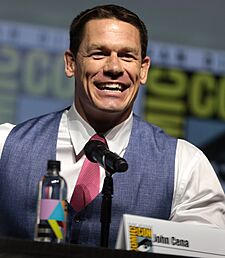
Many notable people have connections to West Newbury:
- John Cena: A well-known professional wrestler, actor, and musician.
- Raymond Abbott: An author.
- Pat Badger: The bassist for the rock band Extreme.
- Bertrand R. Brinley: A writer famous for his "Mad Scientists' Club" stories.
- Addison Brown: A judge, botanist, and amateur astronomer.
- John Appleton Brown: An American landscape artist.
- Margaret Coit: A writer.
- Rawly Eastwick: A former professional baseball player.
- Cornelius Conway Felton: An educator and former president of Harvard University.
- Roland Hayes: An African-American singer and composer.
- Julian Steele: A civil rights activist and the first African-American town moderator in Massachusetts.
See also
 In Spanish: West Newbury (Massachusetts) para niños
In Spanish: West Newbury (Massachusetts) para niños


